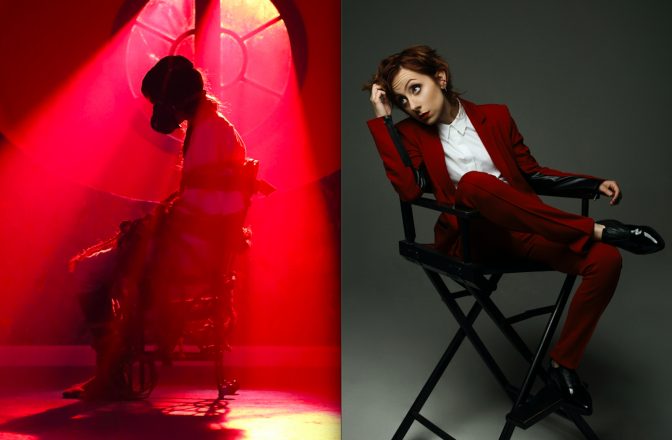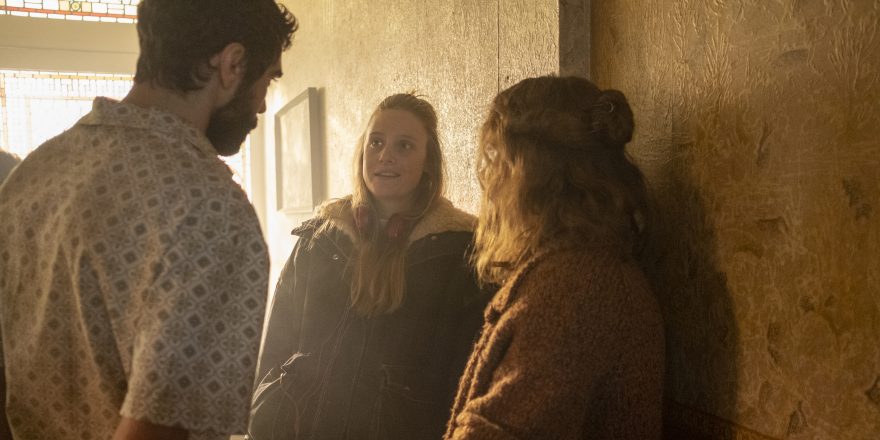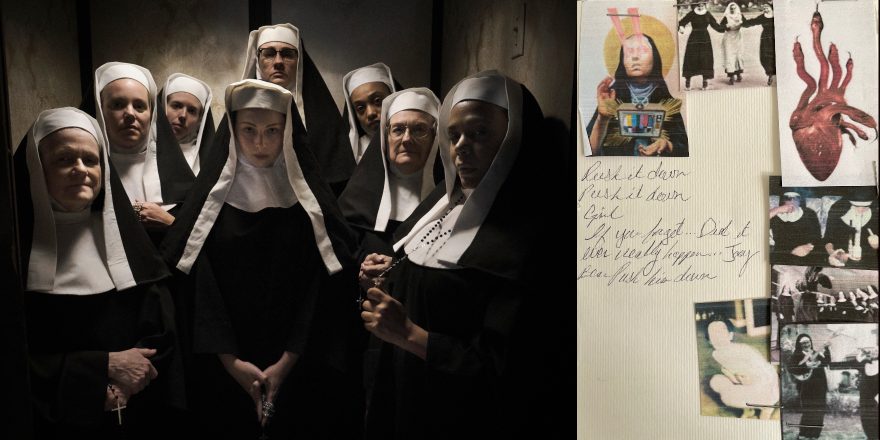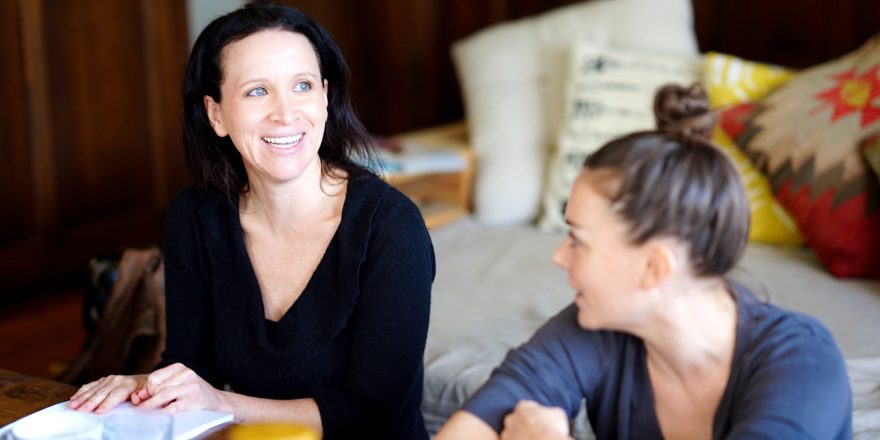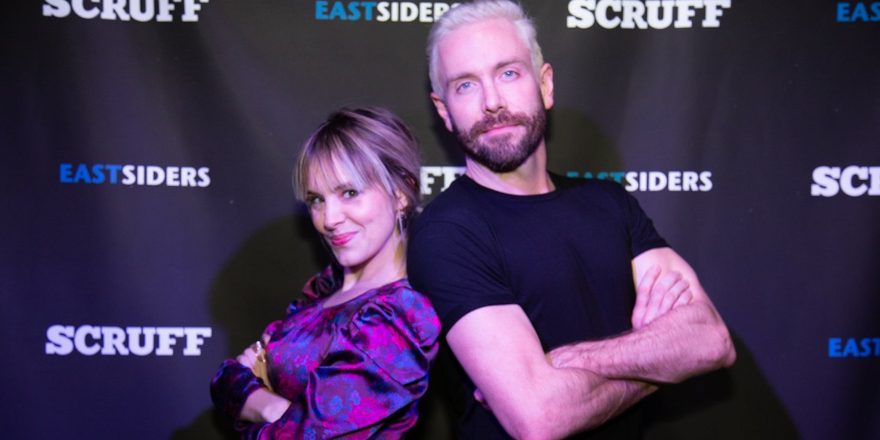I was six years old, hiding inside of a foam apple costume. My dad was speaking to me through the head hole. I told him, “I can’t.”
“You have an incredible memory,” he encouraged me. “Better than me.”
“I don’t want to,” I cried. “I want to go home.”
He explained that the entire production was relying on me, and the shoot couldn’t continue without me.
I was starring in a Fruit of the Loom commercial, and my line got changed on the day of the shoot. It was a long paragraph I had memorized during the audition, and now I needed to relearn this altered version. I wasn’t even out of kindergarten, yet I was already experiencing the pressure and responsibility of being part of a set, part of a team.
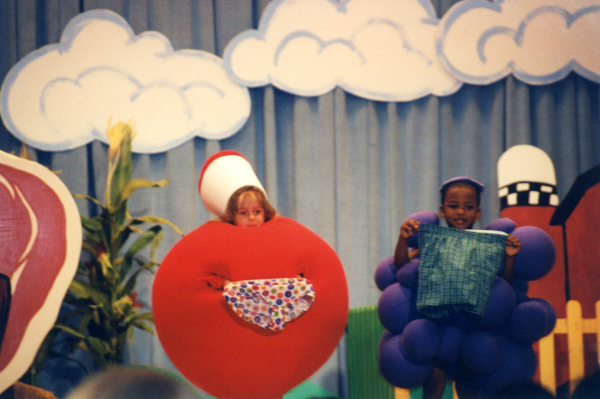
I emerged from my foam apple, rehearsed the new dialogue with him, and the shoot went wonderfully. The director loved me and brought me back for dozens of commercials, and years later even gave me a role in a feature film.
Those memorized words will forever be ingrained into my brain: “Boxers are all the rage this season, especially these tartan plaids. Two-button boxer briefs are also in, while girls like these lovely patterns.” At the time, I didn’t even know what my line meant.
My parents had no idea what we were getting into when they signed me with a manager when I was four years old. I was an outgoing child with abundant energy. They took me to local theatre productions and saw my excitement over the elaborate costumes. I wanted to run up on the stage and play pretend with the actors. I had no idea that for those actors, it was a job. I couldn’t fathom how much work went into it. I was four and I wanted to play dress-up and talk in silly voices.
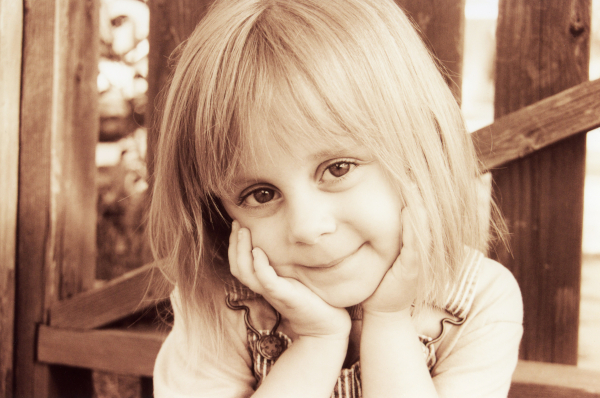
After I attended just one acting class, I was recruited by Lynne Marks, who is still my manager. She began sending me out on auditions and I got work right away. I just thought it was cool that I got to leave school early on days when I had auditions.
I remember sitting in audition waiting rooms filled with girls my age whose headbands matched their brand-new dresses. Meanwhile, I was sweaty in my school uniform with pizza sauce stains; I had no shoes on, and my dad couldn’t even get me to brush my hair. I insisted on running around in circles, claiming that the wind blowing through my hair would get out the knots. He was never one to argue, enjoying my creative logic, and after I began booking jobs, he stopped asking me to brush my hair, saying, “Whatever you’re doing in the audition room, I guess just keep doing it.”
What was I doing in the audition room? At that time, just having fun.
I learned a lot about the world very early. I remember running lines with my dad, and him having to explain to me what divorce was, what affairs were. I remember auditioning for characters with disabilities, an incredibly fine line to walk as an adult, and nearly impossible for a child to understand whether that’s even something they’re comfortable portraying.
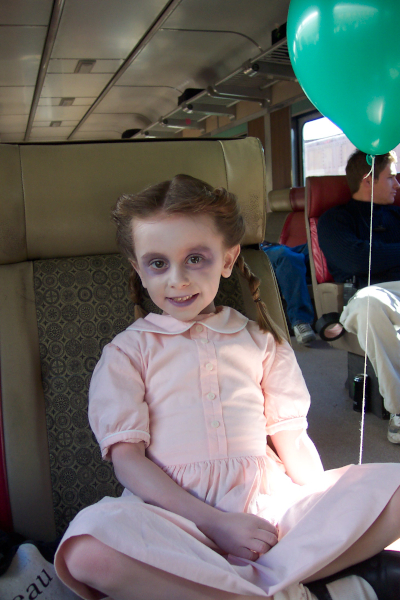
In 2002, at the age of six, I learned that kids can get cancer when I was hired to play a dying child on an episode of Strong Medicine. I was a very pale and skinny kid, so I played sick children often. The following year, I was cast as a ghost on an episode of the paranormal crime series Miracles. There was a scene where I had to lay still on a cold table as the woman playing my mother came in to identify my body. I remember scratching an itch during a take, and the director telling me I wasn’t allowed to move after he said “action.” This was when I learned to put the job before my personal comfort. I learned to suck it up until I heard “cut.”
That same year, I was hired to play one of Phoebe’s triplets on the final season of Friends. I had no idea how huge the show was; I was just excited that I had been tasked with throwing bagels at a grown man, whom I later learned was Matthew Perry.
My parents were also unaware of the global reach of Friends. We preferred movies over television. Our family lived around the corner from a Blockbuster and adored walking there and back, picking out a new movie almost every night.
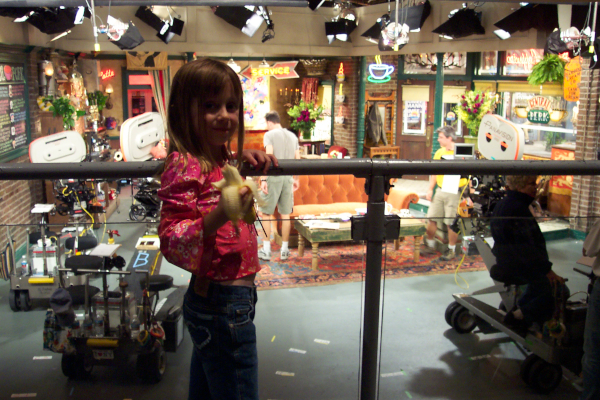
My dad and I have always adored film and storytelling. We spent countless hours together writing and brainstorming movie ideas while driving to and from auditions. I invited friends over almost every weekend to bring our projects to life. I would distribute scripts at school, even recruiting my friends’ parents and several of my teachers.
As my acting career grew, I was able to funnel more funds toward our home movies, which became increasingly elaborate. My dad and I learned so much from the hundreds of sets we were on together. I specifically remember working on a television series called 10-8: Officers on Duty, in which I played a little girl who nearly gets hit by a car. In an intense action sequence, a cop chases after an unmanned car as it speeds down a hill toward me. He jumps in the moving vehicle and hits the brakes just in time, the car stopping just inches from my face. For safety, production didn’t want a car rolling down a hill in the direction of a young child, so they filmed the entire sequence in reverse. They had me stand still, starting the car right in front of me, then speeding it backward up the hill.
My dad and I were blown away, and began experimenting with this technique at home. I can’t even count the number of times I’ve laid on the hood of our family car while my mom kicks it into reverse, and my dad films as I roll off and land back on my feet. We would reverse the clip and shock my school friends with footage of me getting hit by a car.
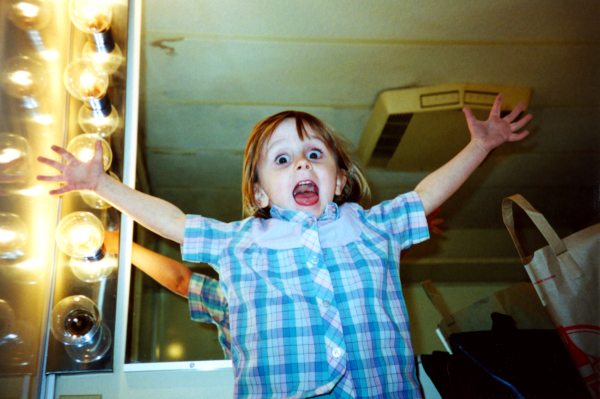
At age 11, after extensive network testing, I was cast in the Disney Channel sitcom Sonny with a Chance. As always, I was happy for the work, but the enormity of this role hadn’t sunk in yet. By age 12, the show was greenlit and I began working full time. My parents made the decision to pull me out of school and start homeschooling.
I was the youngest cast member on the show, and became somewhat of a little sibling in the eyes of my co-stars. I grew isolated from other kids my age, rarely seeing my former schoolmates.
Acting was no longer my after-school hobby, an excuse to miss pop quizzes. Not only was this my first job as a series regular, it was my first time appearing on a kids’ television series. Until then, I had rarely been recognized in public because of my work, and never with the intensity I was about to experience.

I remember attending a Disney safety meeting with my father just before the show came out. I was sitting next to Bradley Steven Perry from Good Luck Charlie and Ryan Whitney Newman from Zeke and Luther. Gary Marsh, the President of Disney Channel Worldwide at the time, explained to us and our guardians how our lives were about to change forever. He explained that millions of families were going to see us in their living rooms every week, and would feel like they knew us. Mr. Marsh taught us about the dangers of accepting gifts from fans, and recommended various home security systems.
Everything started changing. My parents and I had no idea how to navigate this new world. I remember wearing hand-me-downs and thrift store dresses to red carpet events. I remember Googling my name and seeing that a Getty photographer had photographed my Payless shoes.
Twitter was just beginning to blow up as the show was taking off and the internet became the primary place where I socialized with kids my age. Social media is anyway a dangerous world for a prepubescent homeschooler, but having a growing international audience made it that much more complicated. When I posted a photo from an event where I was wearing all black, I was shocked by a slew of negative comments. Someone said, “I didn’t know she was emo,” and I remember thinking, “I didn’t know I was emo either.”
Until that point, when expressing myself in any way – whether writing, filmmaking, painting or putting together an outfit – I had never stopped to ask myself if people would like it. I made decisions based on what I liked. Now I had eyes on me from all over the world.
The most exhilarating part of it all was that strangers were finding the YouTube channel where I posted my home movies. I had an audience, and felt like people cared about my stories.
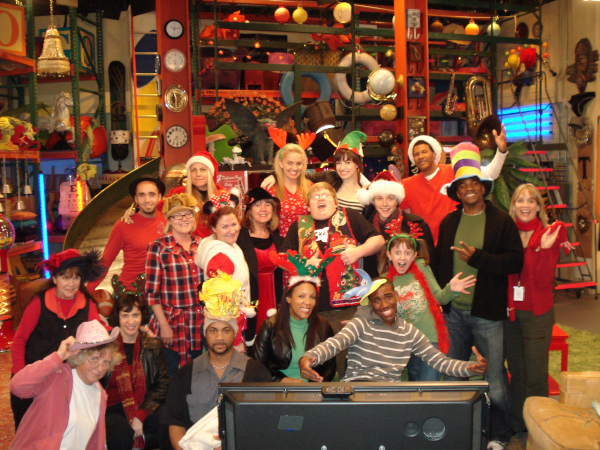
I was such an avid writer throughout my school years, passionate about worldbuilding and creating characters who were extensions of myself. During lunch breaks, my dad and I would brainstorm script ideas in my dressing room, planning out shoots for the weekends. I’ve always put the money I made as an actor back into film; the more I worked, the more wigs and BB guns I could purchase for my home productions.
After two seasons of Sonny with a Chance, and a season of the spin-off series So Random!, my time playing the character of Zora Lancaster was over and suddenly I had free time again. All I wanted to do was devote time to filmmaking.
At age 15, I took the California High School Proficiency Exam (CHSPE) and graduated high school early, allowing me to begin legally working in the industry as an adult, removing the few child protection laws and the social worker insulating me from the full intensity of the entertainment industry. I enrolled in community college, taking classes in animation and cinematography.
The full weight of financial responsibility was starting to sink in as I approached adulthood. Acting had always provided income, but was incredibly inconsistent. Some years I was very fortunate with the work I got, but others my dad would pawn his guitars to keep our home. I hated the unpredictability, and craved a career with stability where I could provide for myself and my family.
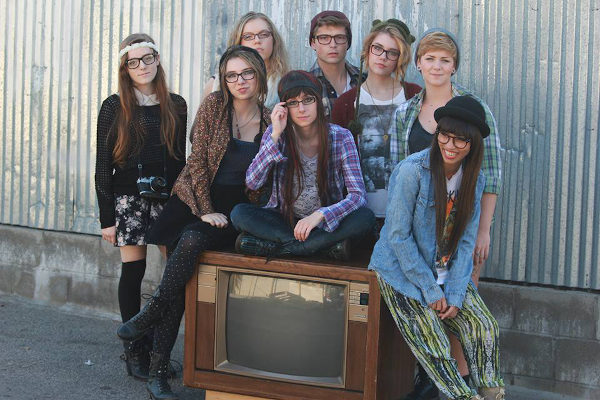
I sold a few skits to AwesomenessTV, several of which aired on Nickelodeon. I continued to grow my YouTube following, starting a new channel where I released weekly videos in my series Astrid Clover, centered around the ambitious but delusional title character I created.
The very last job I took before turning 18 was Hooroo Jackson’s independent film Aimy in a Cage. If I hadn’t taken the CHSPE, I would’ve had a social worker looking out for me on set, enforcing strict working hours. Instead, we were constantly behind schedule, union rules flew out the window, and the production became a demanding and highly stressful experience. For the record, Hooroo Jackson is one of the most brilliant creators I’ve ever met. Unfortunately, control of the set got away from him and it turned into a circus.
Life does not stop when you’re working, and other factors made my experience that much more difficult. My boyfriend at the time chose to break up with me the day I arrived in Boston to shoot the film. A week in, a friend my age passed away from a heart attack back in Los Angeles. We were working 17-hour days with insufficient turnarounds, and I began to fall apart. It was the first time I experienced insomnia. Every night, I was so scared to go back to work the following day, as I somehow believed maybe the next day would never come if I just stayed awake.
My character, Aimy, gets tied to a chair repeatedly throughout the film. I assumed that there would be a safe way to execute this, but the rope was coarse, my arms were usually bare, and the knots had to be tied tightly to stay up. There were lines in the script about my character’s extreme claustrophobia that I didn’t understand until I was fastened to the chair for hours on end, wrists and arms rubbed raw.

My character gets force-fed, beaten with a cane, and scampers around on all fours. My knees were black and blue. An actor I was working with decided that as a character choice, he would grope me and play with my hair. I asked production to intervene, reminding them that I was only 17, but this actor had not yet signed his contract, and their primary concern was that he would walk off set if we upset him.
The shoot wrapped on my 18th birthday. On our second to last day of filming, an actress suffered a severe panic attack from the harsh working conditions, and she threw a knife at me while I was still tied to the chair. Thankfully, it missed, sticking into the wall behind me. At the time it was not funny, but now I try to have a sense of humor about it, joking that I nearly didn’t make it to adulthood. It would’ve been a terribly poetic end to my life as a child actor.
If I tried to write about all the dangerous situations I’ve been asked to endure as an actor, both before and after Aimy in a Cage, this essay would be 50 times as long. All I’ll say is that despite having a knife thrown at my head, Aimy in a Cage is still not the set I’ve felt the most unsafe on. Everyone’s heard the saying “the show must go on.” Breaking it down, this means that actors are rewarded for submitting themselves to physically and emotionally damaging situations for the sake of the job. Productions are keenly aware that it is difficult for actors to walk away from coveted roles for the sake of their own personal safety. Whether it’s because of a passion for movies or a fear of unemployment, they become easily manipulated in this vulnerable state, frequently getting pushed past humane limits. As I work more behind the camera, I am choosing to learn from these challenging experiences to promote safety and good communication on my sets.
There’s nothing I love in this world more than film. It’s how we pass down stories, reworking and reinterpreting them. It’s a moment forever frozen in time, teaching us about others, and how their lives differ from ours. It reveals things we might not experience in our own lives. I want to tell stories. I need to. This has been my whole life. I gave up my entire childhood to be a part of the filmmaking world.
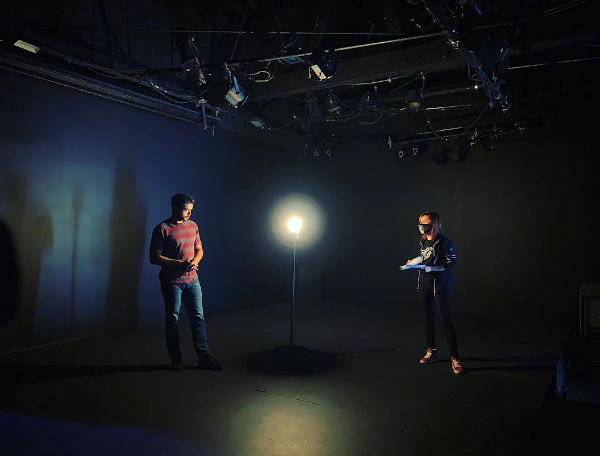
Moving forward, I’m setting new boundaries for myself regarding the sets I’m willing to work on, and for how cast and crew should be treated on my own sets. I know it’s possible to make a movie effectively and efficiently while still having the time of your life. Filmmaking is hard work, but it doesn’t have to be dangerous.
I’ve spent so much of my time absorbing and creating movies. All other work feels like a distraction. I’m ready to turn my passion into a legitimate career. I haven’t often heard of people quitting acting to pursue their dream, but that’s what I’m doing. I’m sure I will occasionally return to the screen as a favor to a friend or for projects I connect with, but for now I am excited to step away from acting and move forward as a filmmaker.
Featured image shows (left) Allisyn Snyder in Aimy in a Cage, and (right) a portrait of her today in the director’s chair. Portrait by Ben Cope, used with permission.



